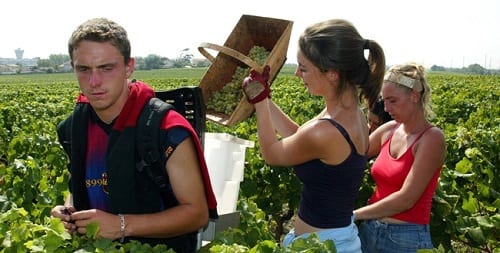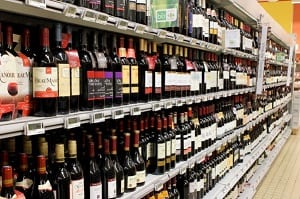This time, I would like to talk about a very symbolic period for winemakers in France: The harvest of wine grapes, also called “Vendange” in French. This practice has been a tradition since Antiquity, and is occurring nowadays from the end of July until the end of September. It is the most important period of the year for wine makers.
Workers are usually hired to help harvest the grapes directly in the vineyards. They are mainly local youngsters and students, but more and more foreigners are participating as well, coming from all over the world. This activity has always been appealing for foreigners, since it has a very strong cultural aspect and is a good occasion to meet new friens . In some cases, however, they can be hired only if the landowner has no other choice (no local workforce available, for instance). The “vendanges” agreement cannot exceed one month, even though workers can apply in several domains successively. There are two main categories of workers:–The “cutters”, or “gatherer” collect the grapes using secateurs.There are two main categories of workers:–The “cutters”, or “gatherer” collect the grapes using secateurs.–The “carriers” recuperate the clusters in huge wicker or plastic baskets that they carry on their back. They transport grapes in boxes weighing 15 to 30 kgs. Cutters are paid 9.61€ per hour in average. Since their job is more demanding physically, carriers are paid 9.95€ per hour. Harvesters work from 35 to 39 hours per week in average.
 Cutters and carriers
Cutters and carriersThrough this unique and festive experience, harvesters learn team working, test their physical limits and meet new people. For the majority of those workers, “Vendanges” are often their very first seasonal job.Depending on the domain they are working in, they can have access to accommodation, meals are usually offered, and the land owner will usually organize a party when the harvest is done. If the land owner is thankful enough, and the workers lucky, they can even receive a free bottle of wine!High quality (resulting from manual harvest) and standard wines (generally produced through mechanical harvest) are sold in supermarkets, but for very specific products and appellations, one must meet directly the producer in their wine cellars. Online wine selling is also a growing trend. The advantages of this purchasing process are clear for the customers: They have access to a wider range of products, and the wine is delivered directly at home. Since some specific products can be quite expensive, they can also have access to other consumers’ comments to help them choose more easily between brands, prestigious domains’ names and “millésimes”.
 Wine barrels in the Patriarche Cellars, Beaune (Burgundy)
Wine barrels in the Patriarche Cellars, Beaune (Burgundy) Wines sold in supermarkets
Wines sold in supermarketsThe “millésime” (or vintage) is a word used to refer to a particular period of harvesting. It can also be used years or even decades later as a reference to a particularly memorable year of production. For instance, the year 1969 was known for being an exceptionally good year for red wines in Burgundy.It is too early to tell if the year 2015 will be good or bad, even though the prospects based on weather have been positive so far.A few specialized websites list the best vintages for each region. The two main wine-producing areas in France are Burgundy and Bordeaux. There is an ancestral competition between those two regions for the title of best wine-producing location. If I dare to compare, it is very reminiscent to me of the Osaka-Hiroshima best お好み焼きrivalry!
 The castle of Clos-Vougeot, the most famous wine domain in Burgundy
The castle of Clos-Vougeot, the most famous wine domain in Burgundy

































































